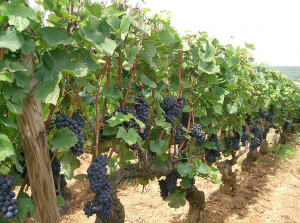Maya: You know, can I ask you a personal question, Miles?
Miles: Sure.
Maya: Why are you so into Pinot? I mean, it's like a thing with you.
Miles: [Laughs softly] Uh, I don't know, I don't know. Um, it's a hard grape to grow, as you know. Right? It's uh, it's thin-skinned, temperamental, ripens early. It's, you know, it's not a survivor like Cabernet, which can just grow anywhere and uh, thrive even when it's neglected. No, Pinot needs constant care and attention. You know? And in fact it can only grow in these really specific, little, tucked away corners of the world. And, and only the most patient and nurturing of growers can do it, really. Only somebody who really takes the time to understand Pinot's potential can then coax it into its fullest expression. Then, I mean, oh its flavors, they're just the most haunting and brilliant and thrilling and subtle and... ancient on the planet.
-Sideways, 2004
Miles' obsession with Pinot Noir in Sideways has given the fruity, subtle wine a renewed popularity in recent years. But what is it about this wine that's just so good?
The most appealing aspect of Pinot Noir may be its soft and velvety texture. Its flavors are invariably delicate and complex, but subtle. It is a smooth wine, easy on the palate. Pinot Noir varies greatly from bottle to bottle, but it generally falls into one of two categories: Old World and New World.
Old World Pinot Noir is light-bodied, with fruit flavors taking a backseat to earthy ones. Common flavors are mushroom, smoke, spice, and tart red fruits, like cranberry. New World Pinot Noir is full-bodied and fruit-forward. It often has flavors of juicy fruits, such as strawberries or raspberries, and also flavors of flowers, toast, or red meat, particularly bacon. The two categories are not necessarily mutually exclusive, so certain Pinot Noirs can exhibit flavors form both styles. Also, "Old World" and "New World" do not refer to regions; wines from America, for example, can follow the Old World style.
Pinot Noir is a particularly good wine to pair with food. It is flavorful enough to stand up to rich flavors, and smooth enough to not interfere with more delicate ones. It pairs well with fishes and leaner meats, but can go well with red meat provided the dish isn't overtly heavy. Spicy or strong-smelling foods also go well with this subtle wine.
In Sideways, Miles is absolutely telling the truth when he waxes poetic about how difficult Pinot Noir grapes are to grow. They are unusually fickle, requiring warm days and consistently cool nights. The classic region in which to grow Pinot Noir grapes is Burgundy, France. This two mile-wide, thirty mile-long stretch of gentle hills has produced the best and tastiest Pinot Noir grapes since the beginning of of winemaking. Burgundy's hills slope towards the East, providing its vines with many hours of sun exposure each day but protecting them from the intense afternoon heat. The soil is also high in calcium carbonate (this kind of soil is often called "chalky"), which means that the soil drains easily and retains a higher average temperature, making it conducive to ripening.
of winemaking. Burgundy's hills slope towards the East, providing its vines with many hours of sun exposure each day but protecting them from the intense afternoon heat. The soil is also high in calcium carbonate (this kind of soil is often called "chalky"), which means that the soil drains easily and retains a higher average temperature, making it conducive to ripening.
Pinot Noir seems to reflect more Gout de Terroir, or flavor of the soil, than other types of black grapes. The ideal soils of Burgundy make for a great product. But grown in inferior regions, Pinot Noir can easily be flat-tasting and flavorless. Although for many years a good Pinot was hard to find, now impressive vintages can be found all over the world, not just in Burgundy. Oregon, California, New Zealand, Australia, Germany and Italy have all produced quality Pinot Noir.
So the next time you're sipping a glass of Pinot Noir, enjoying the smooth texture and the complexity of flavors, consider how much expertise went into growing the perfect Pinot Noir grapes. And if you've never really gotten to know Pinot Noir, now is the perfect time to swing by your local wine shop and extend your hand in friendship.


